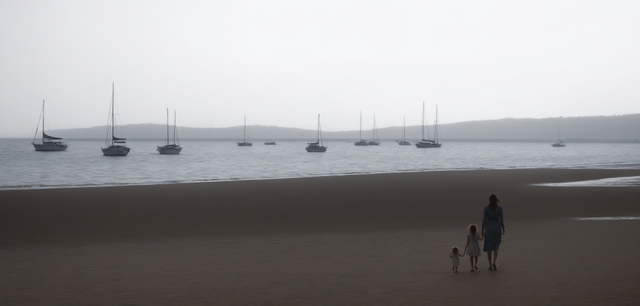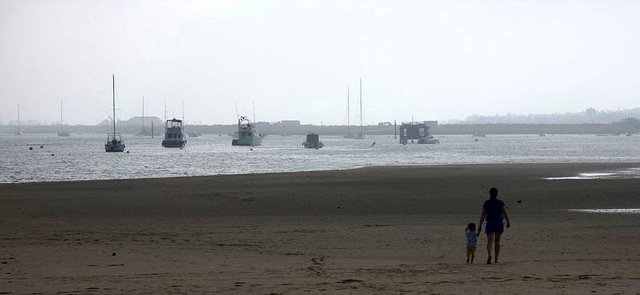Photo Analysis. How something so simple can be full of meanings.
Hello everyone, and welcome to this new post series about photography, images, and their deeper meanings.
It has been a long time since I last used this channel, and I plan to use it, alongside Instagram and Youtube, to publish informative content. I hope to be consistent this time, and I'm writing this to motivate myself not to give up after a few posts.
The photos I'll be sharing will always be original and taken by me. Occasionally, I'll use AI enhancements to add an artistic touch to the composition. I'll also include philosophical references in my posts to enrich the explanations and make the content more engaging.

Transition, Change, Hope, Waiting, and Reflection: An Integrated Analysis with Philosophical References
Technical and Narrative Details:
- Composition: The photo is well-composed, with the horizon neatly separating the sky from the sea. The boats are evenly spaced across the water, creating visual interest. The human figures in the foreground serve as focal points, adding an emotional layer to the scene.
- Depth of Field: The image has a wide depth of field, keeping both the foreground and background vessels in sharp focus.
- Light and Color: The lighting is soft and diffused, creating a calm ambiance. The colors are desaturated, with gray and bluish tones, contributing to the sense of calm and reflection.
The image captures a coastal scene with a hazy horizon, where several boats are anchored. In the foreground, an adult figure holds the hand of a child, who in turn holds a smaller child's hand, as they walk together towards the sea. This scene is a powerful visual representation of transition and change, intertwined with ideas of hope, expectation, and reflection. We will delve into these concepts and analyze the image through the lens of renowned philosophers who have explored similar themes.
Reflection and Inner Calm
The haze and the absence of direct sunlight create an ethereal, contemplative atmosphere. The scene evokes a sense of serenity and introspection. The slow walk of the adult and child along the beach suggests a moment of quiet reflection, where each step is a thoughtful pause, embodying inner calm. This concept resonates with the philosophy of Sören Kierkegaard, who explored the significance of inner reflection and faith in the face of anguish and uncertainty. Kierkegaard's notion of a "suspension of ethics," where an individual makes a "leap of faith," parallels the serenity and calm required to navigate uncertain futures. Anxiety is central to Kierkegaard's thinking. He views anguish as an inherent consequence of human freedom. When confronted with the vastness of choices and responsibilities, individuals experience uncertainty and anguish. However, Kierkegaard sees this state not as purely negative but as an opportunity for personal and spiritual growth. Calmness, in this context, becomes the ability to face anxiety and uncertainty with composure, essential for living an authentic life. Accepting one's fears and taking a leap of faith allow the individual to find inner peace. This serenity is not the absence of conflict or doubt but a deep awareness and trust in a higher meaning and purpose beyond uncertainties.
Hope and Waiting
The fog covering the horizon symbolizes the unknown future, while the stationary boats represent a temporary pause, signifying a patient wait for new beginnings. The soft light hints at a glimmer of hope on the horizon, despite the uncertainty. The presence of children walking alongside the adult embodies the future, trust, and positive expectation. Immanuel Kant addressed the concept of moral and rational progress, suggesting that humanity is constantly striving towards an ideal of perfection. This idea of progress fuels hope that, despite current challenges, the future holds significant improvements. Kant firmly believed in humanity's capacity for progress, not only technologically and scientifically but also morally and rationally. He attributed this progress to the use of reason and the moral autonomy of individuals. According to Kant's ethical theory, moral progress is linked to the categorical imperative, a principle that guides moral action and leads to viewing humanity as capable of developing a moral consciousness. This ideal, known as the realm of ends, envisions a society where individuals are treated as ends in themselves, with moral laws followed out of respect rather than fear or reward. Kant's vision of moral and rational progress inspires hope for a better future and encourages individuals to contribute to societal improvement through reason and moral behavior.
Transition and Change
The image captures a moment of transition, where the past and future converge in the present. The boats, ready to depart yet temporarily anchored, and the walk towards the sea symbolize the movement towards new horizons and change. The haze adds a dreamlike quality, indicating that change is an uncertain yet inevitable journey. The adult and children represent the path of growth and transformation. Martin Heidegger, with his philosophy of Being and Time, introduced the concept of "Dasein," highlighting the understanding of one's existence. Heidegger's Dasein describes the human being as uniquely aware of its existence and capable of reflecting on it. This awareness sets humans apart and emphasizes the transient nature of life. Heidegger views existence as a continuous process of transition and becoming, influenced by temporality. The past (Gewesenheit), present (Gegenwart), and future (Zukunft) are integral to his philosophy, with each step towards the water representing a movement towards the unknown future. Heidegger's philosophy invites us to reflect on our existence, temporality, and the importance of living authentically.
Contemplation and the Present
The calm, foggy beach scene invites contemplation of the present, encouraging a mental pause and evaluation. Gaston Bachelard, in his "Poetics of Space," explores how environments shape our imagination and inner reflection. Bachelard deviates from his scientific focus to investigate the world of poetry and imagination, delving into intimate spaces such as the house, rooms, corners, and the beach. His phenomenological analysis examines how these spaces influence our inner experiences and sense of self.
- Transition between Earth and Sea: The beach represents the transition from land to sea, symbolizing the connection between stability and change, the known and the unknown. It invites contemplation of the infinite sea and our place in the world.
- Open Space: The vastness of the beach and the infinite horizon encourage a sense of freedom and openness, inviting us to expand our thoughts and explore new ideas. The absence of physical boundaries may reflect the freedom of mental exploration.
- Natural elements: The natural elements of the beach, such as sand, water, wind, and sun, have a calming and meditative effect, facilitating a connection with nature and our inner selves. The sensory stimuli of the beach anchor us in the present and promote reflection.
Contemplation of the present and inner calm are essential for navigating life's transitions with serenity.
New Beginnings and Births
The presence of the child walking beside the adult symbolizes new life and new beginnings. This concept aligns with the thinking of Hannah Arendt, who emphasized "natality" as the potential for new beginnings inherent in human action. Arendt argued that each birth represents new possibilities and stories that weave into the tapestry of human history. This concept of birth instills hope and expectation for the future, symbolized by the child's walk.
Being and Time
Heidegger further explored the link between human beings and time, viewing our existence as a continuous becoming. His concept of "being-for-death" highlights that our awareness of mortality motivates us to find meaning in our daily actions and choices. This awareness is reflected in the image, where each step towards the water represents a choice and a movement into the future.
Waiting and Spirituality
Simone Weil delved into the idea of waiting as an integral part of spiritual experience. Her reflection on patient expectation and greater meaning aligns with the calm and reflection depicted in the image. Weil viewed waiting not as passive but as an intentional and hopeful act, akin to the confident walk of the child towards the water with the adult. Weil introduced "attention" as a crucial aspect of waiting, a form of mental and spiritual openness that deepens our perception and understanding of reality. Waiting, in this context, involves being receptive and vigilant, actively hoping for something meaningful to unfold. Hope, according to Weil, is a theological virtue, linked to faith and love. It entails a profound trust in the order and transcendent dimension of the world, believing that every moment of waiting holds value and meaning. Thus, waiting becomes an act of will and attention, an active form of hope that fosters resilience and a deeper perspective.
Modernity and Uncertainty
Finally, Zygmunt Bauman characterizes modernity as a state of constant transition and uncertainty in his concept of "liquid modernity." Bauman describes modern social relationships and structures as fluid and ever-changing, reflecting the theme of transition and change in the image. Hope and expectation persist in the search for stability and meaning within this fluid environment.

Conclusion
This image is a nuanced portrayal of the mental state of transition and change, intertwined with hope, expectation, and reflection. The visual and technical elements evoke a sense of inner calm as one confronts the unknown, waiting with anticipation and hope for the future. The philosophical perspectives of Kant, Kierkegaard, Heidegger, Bachelard, Arendt, Weil, and Bauman enrich our understanding of these concepts and provide a deeper analysis of the scene. The image invites viewers to reflect on their life journeys, find peace in moments of pause, and cultivate hope and confidence as they embark on new paths."